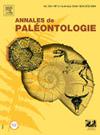泰国东北部那空拉差斯玛的中新世和更新世大陆新地点及其对脊椎动物生物地理学的重要性
IF 0.7
4区 地球科学
Q4 PALEONTOLOGY
引用次数: 0
摘要
本文描述了泰国东北部呵叻府披迈县 Sin Charoen 沙坑出土的两个新化石群。在该省,从中新世到更新世的沉积物中都发现了脊椎动物化石。中新世动物群在 Chaloem Phra Kiat 县的几个地方都有丰富的化石记录,对其进行了详细记录,而更新世动物群则在 Mueang Nakhon Ratchasima 县的 Khok Sung 沙坑进行了深入研究。Sin Charoen 沙坑上段的化石群与 Khok Sung 的中更新世动物群相似,都由哺乳动物和爬行动物的已灭绝和现存物种组成。此外,与爪哇早-中更新世动物群(如特立尼达)的关系也很密切。Sin Charoen 沙坑中出现的大型流纹龟和长吻龙表明,过去的河流系统比现在发达,而且沉积时的呼叻高原海拔较低。下段的化石群包括两种犀牛类和一种高级的犀牛属动物,与在 Chaloem Phra Kiat 区沙坑中就地发现的晚中新世动物群相似。本文章由计算机程序翻译,如有差异,请以英文原文为准。
A new Miocene and Pleistocene continental locality from Nakhon Ratchasima in Northeastern Thailand and its importance for vertebrate biogeography
Two new fossil assemblages are described from Sin Charoen sandpit exploited in Phimai District, Nakhon Ratchasima Province, Northeastern Thailand. In this province, vertebrate fossils have been yielded from the Miocene to the Pleistocene deposits. The Miocene fauna has been documented in detail by a rich fossil record from several localities in Chaloem Phra Kiat District, while the Pleistocene fauna has been well studied in Khok Sung sandpit in Mueang Nakhon Ratchasima District. The fossil assemblage from the upper section of Sin Charoen sandpit is similar to the Middle Pleistocene fauna of Khok Sung, which is composed of extinct and extant species of mammals and reptiles. Moreover, the finding of Gavialis cf. bengawanicus and Duboisia santeng demonstrates a strong faunal relationship with Early-Middle Pleistocene faunas of Java (e.g., Trinil). The occurrence of large fluviatile turtles and gharials from Sin Charoen sandpit indicates that the past river system was more developed than today and that the Khorat Plateau was at a lower elevation at the time of deposition. The fossil assemblage from the lower section includes two rhinocerotids and an advanced form of the genus Stegolophodon and is similar to the Late Miocene fauna found in situ in the sandpits of Chaloem Phra Kiat District.
求助全文
通过发布文献求助,成功后即可免费获取论文全文。
去求助
来源期刊

Annales de Paleontologie
地学-古生物学
CiteScore
1.70
自引率
10.00%
发文量
8
审稿时长
>12 weeks
期刊介绍:
Créées par Marcellin Boule en 1905, les Annales de Paléontologie publient 4 numéros par an traitant des fossiles animaux et végétaux, dans tous les domaines de la paléontologie incluant :
-La Paléoanatomie-
La Paléohistologie-
La Morphologie fonctionnelle-
La Systématique-
L''Évolution-
La Paléoécologie
... et toute les contributions susceptibles d''améliorer la compréhension des organismes et des environnements éteints.
 求助内容:
求助内容: 应助结果提醒方式:
应助结果提醒方式:


